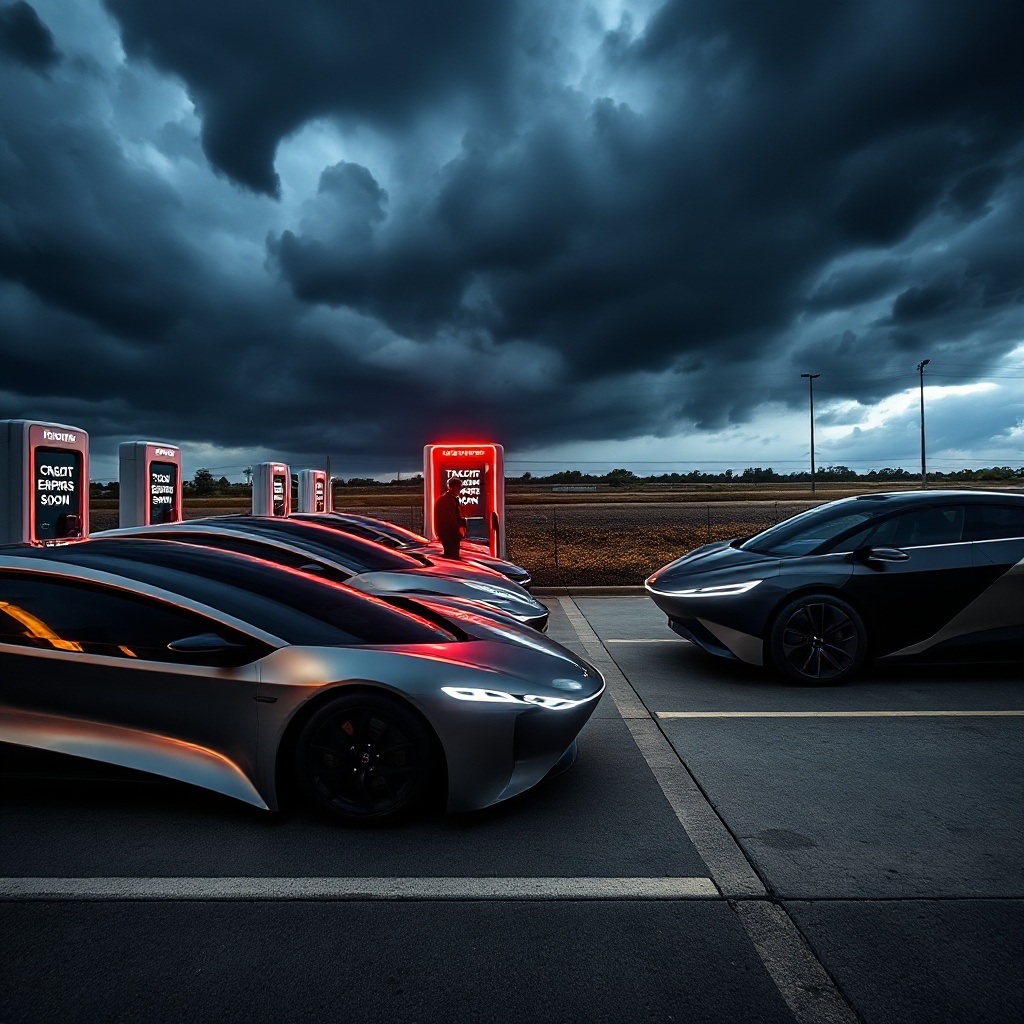
US EV startups face crisis as $7,500 tax credit expires, creating boom-bust risk while Chinese rivals dominate global market with 60% share versus America's 10%.

Drivetech Partners
America's emerging electric vehicle startups face a precarious future as they grapple with policy uncertainty and intensifying global competition. The looming expiration of the $7,500 federal EV tax credit threatens to create a boom-and-bust cycle that could leave U.S. manufacturers further behind their European and Chinese counterparts in the rapidly evolving EV marketplace.
Key Takeaways
The $7,500 federal EV tax credit is set to expire after December 2025, potentially creating a short-term sales surge followed by a market crash
U.S. startups hold a small position in the global EV race, with China dominating at 60% of new EV registrations compared to just 10% for the U.S.
After 2025, only manufacturers with fewer than 200,000 qualifying sales since 2010 will remain eligible for tax credits, potentially benefiting smaller startups like Lucid and Rivian
Successful EV startups are diversifying beyond manufacturing into support services like charging infrastructure to create new revenue streams
The U.S. EV market is projected to grow from $95.90 billion in 2025 to $221.46 billion by 2032, despite policy challenges
The Race Against Time: Current EV Market Dynamics
The U.S. electric vehicle market stands at a critical inflection point. With a 7.5% market share in Q1 2025—up from 7.0% in Q1 2024 but down from 8.7% in Q4 2024—the industry shows signs of volatility. Total EV sales reached 294,250 units in Q1 2025, representing an 11.4% year-over-year increase, but this growth faces serious headwinds.
At the center of this uncertainty is the looming expiration of federal incentives. The $7,500 federal EV tax credit is set to end for most vehicles after December 31, 2025, with Senate proposals potentially moving this deadline even earlier to September 30, 2025. Additional incentives including the $4,000 tax credit for used EVs and up to $1,000 for home chargers will also disappear after 2025.

This policy cliff has created a ticking clock for both consumers and manufacturers. The market faces a likely short-term sales acceleration as buyers rush to claim credits before expiration, followed by a potential crash once incentives vanish. For startups already operating with thin margins and high capital requirements, this boom-bust cycle poses an existential threat.
Global Competition: America's Uphill Battle
The global context makes the situation even more challenging for U.S. startups. China has established overwhelming market dominance, accounting for 60% of new EV registrations in 2023. Europe follows at 25%, while the U.S. trails significantly at just 10%. This gap extends beyond sales figures into innovation metrics.
China leads in patent activity with over 79,340 EV-related patents, compared to the U.S. with 54,560. This innovation disparity suggests that without strong and consistent policy support, U.S. manufacturers risk falling further behind as their international competitors continue aggressive investments in technology, infrastructure, and manufacturing capacity.

Analysts from multiple sectors warn that abrupt U.S. policy reversals may widen the technology gap between domestic startups and global competitors. By 2030, the global EV fleet could reach 476 million vehicles—a substantial figure but still short of what's needed to meet net-zero climate targets. Without stable policy support, U.S. companies may capture an even smaller slice of this expanding market.
Startup Survival: The Fight for Market Relevance
Among U.S. startups, Lucid and Rivian have established relatively stable positions due to their early market entry and substantial capital backing. These companies face a complex competitive landscape dominated by Tesla, which holds a 43.4% share of the U.S. EV market despite a 9% year-over-year sales decline.
Ironically, the tax credit expiration creates a potential competitive advantage for smaller players. After 2025, only EVs from manufacturers with fewer than 200,000 qualifying sales since 2010 would remain eligible for tax credits. Major brands like Tesla, GM, and Ford would lose eligibility, while startups including Lucid, Rivian, Honda, and Jaguar/Land Rover could still offer vehicles with tax advantages.
Nevertheless, new entrants continue to struggle with high upfront costs, rising interest rates, and a market increasingly dominated by legacy automakers with deeper pockets and established production infrastructure. General Motors doubled its EV sales since Q1 2024, and Ford's EV sales increased slightly, demonstrating the growing strength of traditional manufacturers in the electric space.
Innovation as a Lifeline: Strategic Pivots
Facing these challenges, successful startups are increasingly diversifying their business models. Many are shifting focus to support services, such as charging infrastructure, rather than competing solely in the crowded vehicle manufacturing space. This strategic pivot allows them to leverage their technological expertise while avoiding direct competition with established automakers.
Battery Electric Vehicles (BEVs) will represent 69.3% of the U.S. EV market in 2025, driven by improved battery technology. For startups, advancing battery tech, expanding charging networks, and improving vehicle range have become critical for competitive survival.
The proposed discontinuation of commercial EV and leasing incentives further complicates the landscape, forcing startups to identify new revenue streams. Despite these challenges, the total U.S. EV market value is projected at $95.90 billion in 2025, expected to reach $221.46 billion by 2032 (CAGR 12.7%)—offering substantial opportunities for those who can navigate the turbulent transition.
The Boom-and-Bust Cycle: Market Risks
U.S. startups now face a potential market whiplash: a surge in sales as consumers rush to claim tax credits before expiration, followed by a steep decline once incentives disappear. This cycle could accelerate startup failures and cede market share to established global competitors who can better weather the volatility.
The strength of legacy automakers compounds this challenge. General Motors doubled its EV sales compared to Q1 2024, and Ford's EV sales increased slightly. These established manufacturers have the financial resources to sustain operations through market downturns, an advantage most startups lack.
Looking beyond immediate challenges, the global EV market is expected to reach $2.52 trillion by 2034, growing at a CAGR of 11%. This long-term growth trajectory offers hope, but policy uncertainty and abrupt tax credit changes remain the most significant risks to the U.S. EV startup ecosystem.
Navigating the Policy Maze: Adaptation Strategies
In response to these challenges, startups are developing strategic transition plans for the post-credit environment. These include creative financing options to offset the loss of tax incentives for consumers and accelerating delivery timelines to ensure customers can claim credits before expiration.
Small-volume manufacturers may benefit from extended eligibility, creating a unique competitive advantage in the post-2025 market. Understanding the complex eligibility requirements has become essential for both manufacturers and consumers as they navigate the changing landscape.
Several companies are also exploring alternative business models, including:
Subscription-based ownership programs
Battery leasing to reduce upfront vehicle costs
Partnerships with fleet operators less sensitive to tax credit changes
Targeted international expansion to markets with more stable incentive programs

The Road Ahead: Long-term Outlook for U.S. EV Innovation
Despite immediate challenges, U.S. startups continue to drive technological advancement in batteries, autonomous systems, and manufacturing processes. The innovative spirit that launched these companies remains their greatest asset in the face of policy uncertainty and global competition.
Strategic partnerships between startups and established manufacturers offer potential survival pathways. These collaborations can provide startups with manufacturing scale and financial stability while giving legacy automakers access to cutting-edge technology and agile innovation practices.
U.S. EV infrastructure development remains critical for long-term market growth. Investment in domestic supply chains and battery production will determine future competitiveness, particularly as startups seek to differentiate themselves through technological advantages rather than price points.
International expansion strategies are becoming essential as startups seek to diversify beyond the uncertain U.S. market. By establishing footholds in markets with more stable policy environments, these companies can build resilience against domestic market fluctuations while gaining access to global talent and resources.
The coming years will test the adaptability and resilience of U.S. EV startups. Those that can weather the immediate policy storms while positioning themselves for long-term growth may emerge as leaders in the next phase of the global electric vehicle revolution—but the path forward remains fraught with challenges.
Sources
CarEdge: Electric Vehicle Market Share and Sales
Kiplinger: What's Happening with the EV Tax Credit
Coherent Market Insights: US Electric Vehicle Market




